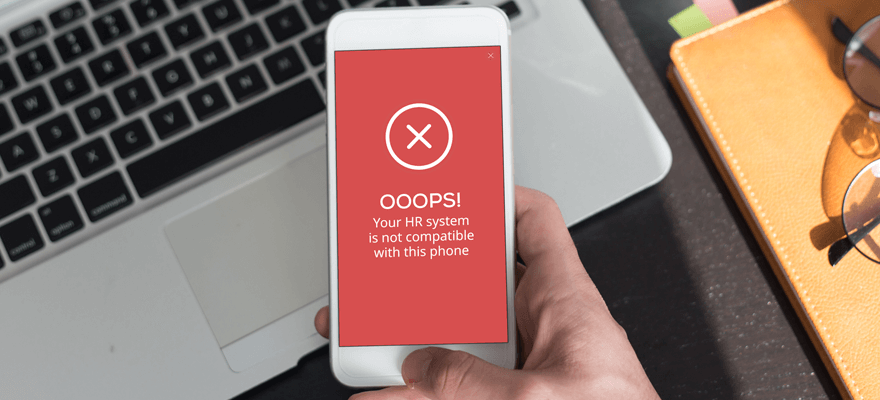Why you should factor backward compatibility when choosing HR apps for your business.
Backward compatibility is a crucial but often overlooked factor of HR apps. Can you be sure your HR software will work properly for employees with older phones?

One of the most overlooked factors when choosing HR apps is backward compatibility.
“What’s that and why does it matter to HR professionals you may ask?”
In this context, backward compatibility is the ability of an HR app to interface not just with the latest operating system but with earlier versions of the operating system that may be on older smartphones that your employees possess.
It can seem strange to be suddenly asked to look back, when HR professionals are constantly being asked to abandon legacy processes and embrace new technologies.
The Technology Adoption Lifecycle
We are not actually asking HR software buyers to go back to the stone age.
However, HR professionals should be aware that employees adopt new mobile phones at varying rates, loosely following something called the Technology Adoption Lifecycle. This is a well-respected sociological model which describes the adoption of new products or innovations. As you can see from the shape of the image below, the technology adoption process in a population (your workforce for example), follows a normal distribution or a bell curve.

Innovators and early adopters come first, followed by the early and late majority, followed by the laggards, (late adopters) who only adopt when it becomes necessary to do so.
These late adopters are statistically significant at 16% – maybe more if you employ a lot of frontline workers. That means 1 in 6 employees are potentially still using older smartphones which may not be compatible with your chosen HR software. This is because modern HR software does have a functional bias toward newer smartphones, held by early adopters.
Apple device usage data shows that around 10% of smartphone owners are using older iOS dating back as far as 2016! Data from Bitdefender shows that around 20% of Android device users are running operating systems that are between 4 and 9 years old.
There is no shame in running older smartphones, even though it may be inconvenient for your HR software implementation. The term laggard derived from the technology adoption model shown earlier is outdated and implies tardiness and fault on the user’s behalf, but nothing could be further from the truth. The reality is that there are so many legitimate reasons why users are not upgrading smartphones.
Experts suggest that high prices, mature markets, slower rates of obsolescence, and a movement away from phone contracts are the reasons behind this trend.
Basically, older phones do everything that consumers really need, e.g. call, text, browse, and run core app. And for many people, there’s simply no pressing functional need to upgrade. It’s a perfectly reasonable position (more so now the cost-of-living crisis is with us), and as a result, the market may need to be more inclusive of the late adopter. In fact, research shows that people are holding on to their smartphones for longer and so it’s a trend that HR software buyers need to get used to.
Therefore, if HR software buyers acquire new HR software without sufficient in-built backward compatibility, then a significant cohort of their workforce will not be able to use the HR app. This will not only reduce the uptake of new software, but will also alienate the late adopters and create a digital divide within your workforce. It will of course negatively impact the ROI of your new HR app implementation, too.
Choose HR software that is backward compatibility tested.
When choosing new HR software, backward compatibility should not be taken for granted. A lot of the HR software in the marketplace may lack backward compatibility and as a result, will not function with up to 20% of your employees’ smartphones. This means that this cohort of staff will struggle to get your new HR app to work on their older smartphone, which is in the context catastrophic, requiring you to invest in inefficient digital workarounds.
This is why HR software buyers should ideally consider HR software such as the SenseHR HR app – a brand new mobile app for the modern workforce, sure, but one that is built and compatibility tested to suit devices that go right back to Android 5 (9 years old), and iOS 9 (7 years ago).
HR apps like SenseHR for mobile are rigorously backward compatibility tested with older operating systems on Android and iOS, which means they will work with all your employees’ phones.
Given the fact that the lifecycle of smartphones is getting longer, backward compatibility is becoming an increasingly important selection criterion in the HR software buying process.
So, when choosing your next HR app ensure that backward compatibility is a key factor to ensure maximum uptake from employees now and in the future. Be sure to question the vendor as to the scope of their product’s backward compatibility, the extent and nature of testing, and what steps they can take to rectify any compatibility issues that may emerge.
